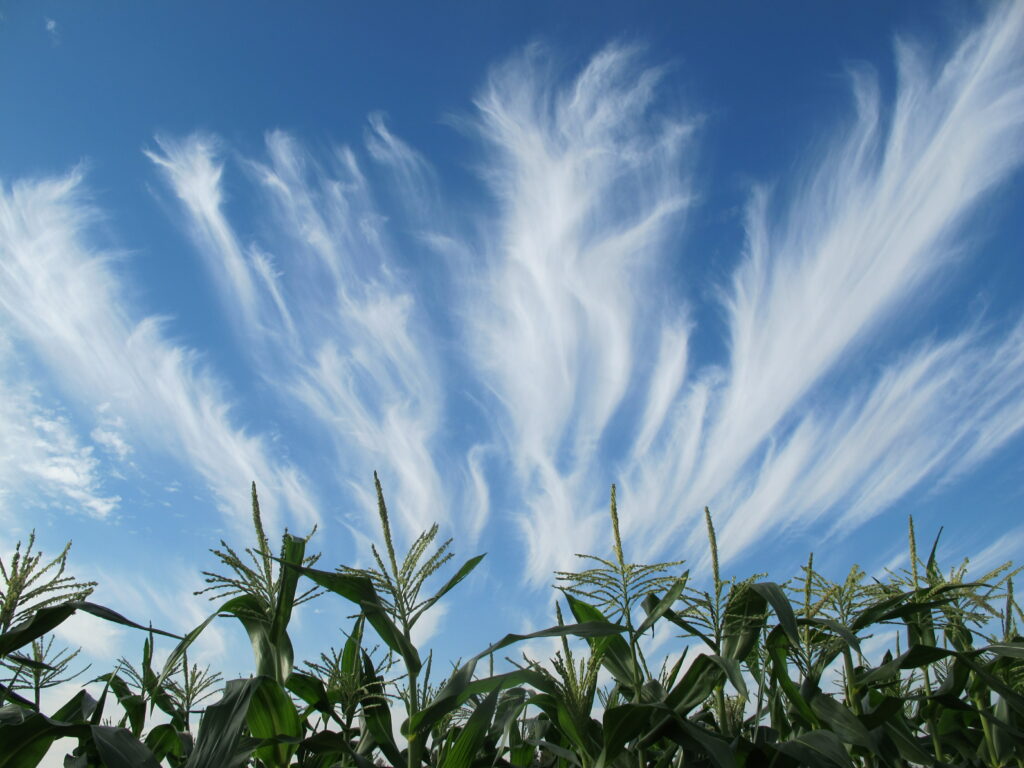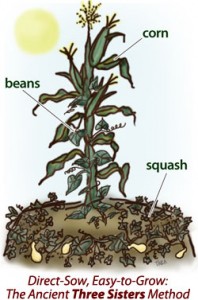
For some time now, your boxes have proudly contained the king of summer, his royal highness The Corn. Every year it accompanies us from June to November, joins us as we bid the schoolyear farewell, enjoys our summer vacation and then goes back to school with us come fall. In essence, the corn crop begins to ripen in June, when the weather turns warm but still has an occasional breezy day, moves headlong into the intolerable heat of July-August and the heatwaves of September, breathes a sigh of relief in October, and makes certain that moderate weather has returned before saying goodbye in November. Now that’s what I call a king!
Corn is probably one of the first crops the Americans learned to grow. Approximately 7,000 years ago, some gleaners (probably Mayan women, or women of a neighboring tribe in Central America) noticed a spontaneous mutant among the weeds, a teosinte, with a cob that was longer and filled with seeds that were larger than your average ancient weed. Something sparked their intuition, and they tasted it – to their great delight. They also discovered that seeds which fell to the ground sprouted and became a mature plant that yielded more cobs. After some time, they learned that if they kept and seeded the better seed varieties, the next crop would be even more improved!
To your left is the olden corn, and to your right is its current cultured form:

At the next stage, they (no longer gleaners, but now also farmers) discovered that if they grow corn, beans and squash, they could actually make a decent basic diet out of them. The plants also grew well together: the corn acted as a supporting pole for the bean to climb upon, and the squash grew on the earth as live mulch, preventing weeds and keeping moisture in.
This threesome, which earned the title “the three sisters,” is an excellent example of the plant guild/community: a group of plants who become valuable when they grow together. The key to their success is the positive reciprocal relationship between them: each plant contributes to its neighbors, and receives from the neighbors in return. And just like human communities, a good plant guild is a more independent entity, stronger, healthier and easier to maintain then growing plants which are not connected to one another. This agricultural development proved to be so time-efficient that it gave the growers enough spare moments to build houses, weave rugs and baskets, develop astronomy and math, and of course – party…
Today, corn is one of the only crops which cannot reproduce without a human helping hand, as it requires the planting of separate seeds in order for the plant to sprout.
In various languages, corn was granted venerable names. The first to bring corn to Europe were the Spanish, who gave it a name from the native Taino: mahis in Taino, maize in Spanish. The meaning in Taino is “the seed that gives life.” The Latin name continued this theme, calling it Zea (life giver) mays.
Only when the wonder vegetable emigrated to Europe did it receive its dull, listless name “corn” that was a generic name for grains (even salt grains, hence “corned beef”), and the derogatory titles “Turkey wheat,” “Turkey/Egyptian corn,” or “Indian corn.” Apparently they were not referring to the origins of the grain, but rather making a social comment that this was an uncultivated, wild, barbaric grain, as compared to “polite” cultured European grains.
The Hebrew name tiras was chosen based on the English “Turkey corn,” or the Yiddish equivalent Tirkishe Veitzen. In an old nature book, The Genesis of Learning, Baruch Linda describes “Turkey wheat” (חטי טורקיא) as “a grain with yellowish round seeds… each plant containing three towers, each tower or stalk containing two hundred and forty adhered seeds.”
So how did the Hebrew tiras derive from the Turkey? The word tiras is mentioned in the Bible in the books of Genesis and Chronicles. Tiras was Jefeth’s seventh son (Noah’s grandson). Scholars identified Tiras as the father of the Turkish nation (Tractate Yoma), which is why the “Turkish” grain was granted this name.
In a letter from 1912, Naomi Shapiro of Kvutzat Kineret described an agricultural summer festival of the day: “We left from Sejera at five AM in six carts with Hebrew and Turkish flags. Nature was impeccably beautiful and thus we arrived in Kineret within two hours, singing and clapping our hands… All sorts of vegetables were displayed from the various farms and moshavot, beans and peas and beets, tiras wheat, pumpkins, squashes, bandoras, cucumbers, grains and wheat – all neatly arranged…” Over the years, the “wheat” was dropped, leaving only the tiras.
Its lackluster name certainly does not reflect the sweet, positive nature of this wonderful grain, upon which the world of South American natives was once so dependent. And perhaps the come-down of the name from “life giving” to “wild grain” somewhat reflects the devaluation of this outstanding plant in the Western world.

Today, too, we are dependent upon corn in every realm, especially food: Almost every processed food contains corn, but corn of a very limited genetically-engineered variety that appears in its processed, worn and abused form, totally bereft of nutritional value, and of course, a product which demands an excessive exertion of energy.
We use corn starch for thickening and gluing, and corn syrup for sweetening. Expansion materials, emulsifiers, food coloring, and citric acid are all are derived from corn, as well as most of the animal fodder in the meat industry. Corn also serves a role in the production of plastic and oil. (If you wish to learn more about corn and food in our world, I highly recommend Michael Pollan’s book, The Omnivore’s Dilemma.)
But for all its many uses, there is nothing like simply sinking your teeth into a fresh ear of corn. There are those who do not trust the Kashrut of corn. They fear that tiny insects lying within the corn silk will find their way into the kernels, becoming impossible to detect and remove. Dror once told me that he heard from a “Sunfrost” mashgiach (kashruth supervisor) how to deal with this matter. According to him, the bugs run towards the cob when they are exposed to light, as the corn is peeled and its silk removed. The solution is simple and creative: peel the corn in the dark! This way, the bugs remain in the silk and get tossed to the compost. You are more than welcome to try this out at home…
Wishing everyone a great week,
Alon, Bat Ami, Dror, Yochai and the entire Chubeza team
__________________________________________
WHAT’S JOINING THE CORN IN THIS WEEK’S BOXES?
Monday: Bell peppers, slice of pumpkin, Thai yard-long beans, cucumbers, okra/onions, tomatoes, corn, cherry tomatoes, butternut squash, parsley/coriander, New Zealand spinach.
Large box, in addition: Eggplant, scallions, potatoes.
FRUIT BOXES: Pears, nectarines, mango. Small boxes only: Bananas Large box only: Grapes
Wednesday: Bell peppers, slice of pumpkin, Thai yard-long beans/garlic, cucumbers, onions, tomatoes, cherry tomatoes, butternut squash, parsley/coriander, New Zealand spinach, eggplant/potatoes.
Large box, in addition: Okra, corn, scallions.
FRUIT BOXES: Pears, grapes, mango. Small boxes only: Bananas Large box only: plums

